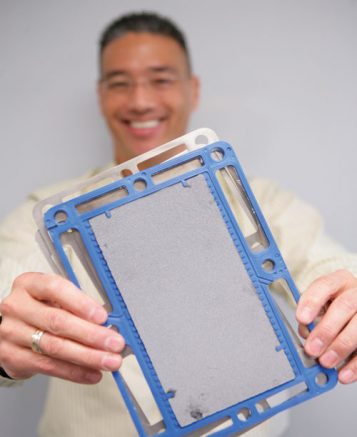FUELING ALTERNATIVES
For the fresh produce industry, where perishable product devalues exponentially with time, supply chain transportation logistics is its lifeline.
When Mike Moynahan, distribution asset design and procurement, came on board, Charles Butt, H-E-B’s Chairman and CEO, had just taken over the reins. According to Moynahan, “Charles really is a person who aspires to greater heights, challenging those throughout the organization to follow his lead: What can we do to make our systems superior, raise safety standards, and become faster, more efficient, more competitive and more sustainable?”

Whether it’s navigating changing federal and state transportation regulations, improving driver safety, designing more proficient/ergonomic trucks, H-tackling cold chain issues or forecasting fuel options, H-E-B takes it on, all within a sustainability mandate. To be truly sustainable, it has to be economical, says Bobby Greene, director of fleet maintenance. “I
personally think electric is more efficient, but it’s expensive, so it’s not efficient now.”
“Very little — some 20 percent — of our Houston fleet runs on alter-native fuels,” adds Moynahan. “We have had up to half our fleet in Houston that was on biodiesel before, but the quality levels are not consistent. It has to be at least as competitive.” H-E-B has since set up a pilot program in Houston, where it is testing liquefied natural gas.
What really holds potential are hydrogen fuel cells, according to Greene. “We’ve been given the opportunity to try products and they do work, but not without problems,” he says. H-E-B, for example, is creating its own hydrogen. “We were the very first retailer to launch fuel cells in a forklift fleet,” contends Greene.
“We generate our own hydrogen reformed out of natural gas. It’s not an economic gain but it is a break-even,” he acknowledges. “It was a doable program, although we had lots of bugs to begin with, but now it’s up and running. Eventually, we want to power our refrigerated diesel trucks with hydrogen, take the diesel engine out and put a fuel cell in. It would be simpler, easier and safer than fueling your car,” says Green.
“H-E-B is way ahead of the curve on fuel cells,” says Green, “but we’re not quite there yet. It takes time to get all the kinks out. Our goal is to replace all batteries with fuel cells.” In the interim, H-E-B has installed high frequency charges in batteries to boost power and reduce labor demands.
Moynahan relishes the learning process. “We’ve dramatically changed how we do business because of the culture at H-E-B,” which allows its partners to experiment with new technologies, and take chances to gain sustained leverage.”




